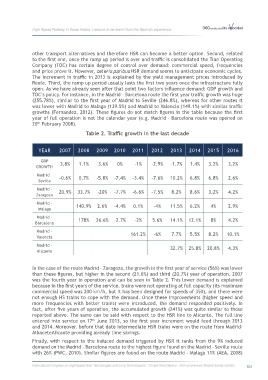Page 525 - 360.revista de Alta Velocidad - Nº 6
P. 525
High Speed Railway in Saudi Arabia: Lessons to be learnt from the Spanish experience
other transport alternatives and therefore HSR can become a better option. Second, related
to the first one, once the ramp up period is over and traffic is consolidated the Tran Operating
Company (TOC) has certain degree of control over demand: commercial speed, frequencies
and price prove it. However, ceteris paribus HSR demand seems to anticipate economic cycles.
The increment in traffic in 2013 is explained by the yield management prices introduced by
Renfe. Third, the ramp up period usually lasts the first two years once the infrastructure fully
open. As we have already seen after that point two factors influence demand: GDP growth and
TOC’s policy. For instance, in the Madrid – Barcelona route the first year traffic growth was huge
(255.78%), similar to the first year of Madrid to Seville (246.8%), whereas for other routes it
was lower with Madrid to Malaga (139.5%) and Madrid to Valencia (149.1%) with similar traffic
growths (Fernandez, 2012). These figures do not match figures in the table because the first
year of full operation is not the calendar year (e.g. Madrid – Barcelona route was opened on
20 February 2008).
th
Table 2. Traffic growth in the last decade
YEAR 2007 2008 2009 2010 2011 2012 2013 2014 2015 2016
GDP 3.8% 1.1% -3.6% 0% -1% -2.9% -1.7% 1.4% 3.2% 3.2%
GROWTH
Madrid – -0.6% 0.7% -5.8% -7.4% -3.4% -7.6% 10.2% 6.8% 6.8% 2.6%
Seville
Madrid –
Zaragoza 20.9% 33.7% -20% -7.7% -6.6% -7.5% 8.2% 8.6% 3.2% 4.2%
Madrid –
Malaga 140.9% 2.6% -4.4% 0.1% -4% 11.5% 6.2% 4% 2.9%
Madrid –
Barcelona 178% 26.6% -2.7% -2% 5.6% 14.1% 12.1% 8% 4.2%
Madrid –
Valencia 161.2% -6% 7.7% 5.5% 8.2% 10.1%
Madrid – 32.7% 25.8% 20.8% 4.3%
Alicante
In the case of the route Madrid – Zaragoza, the growth in the first year of service (56%) was lower
than these figures, but higher in the second (21.6%) and third (20.7%) year of operation. 2007
was the fourth year in operation and can be seen in Table 2. This lower demand is explained
because in the first years of the service, trains were not operating at full capacity (its maximum
commercial speed was 200 km/h, but it has been designed for speeds of 350), and there were
not enough HS trains to cope with the demand. Once these improvements (higher speed and
more frequencies with better trains) were introduced, the demand responded positively. In
fact, after five years of operation, the accumulated growth (241%) was quite similar to those
reported above. The same can be said with respect to the HSR line to Alicante. The full line
entered into service on 17 June 2013, so the first year increment would feed through 2013
th
and 2014. Moreover, before that date intermediate HSR trains were on the route from Madrid-
AlbaceteAlicante providing already time savings.
Finally, with respect to the induced demand triggered by HSR it ranks from the 9% induced
demand on the Madrid – Barcelona route to the highest figure found on the Madrid – Seville route
with 26% (PWC, 2010). Similar figures are found on the route Madrid – Malaga 11% (AEA, 2008)
International Congress on High-speed Rail: Technologies and Long Term Impacts - Ciudad Real (Spain) - 25th anniversary Madrid-Sevilla corridor 523

